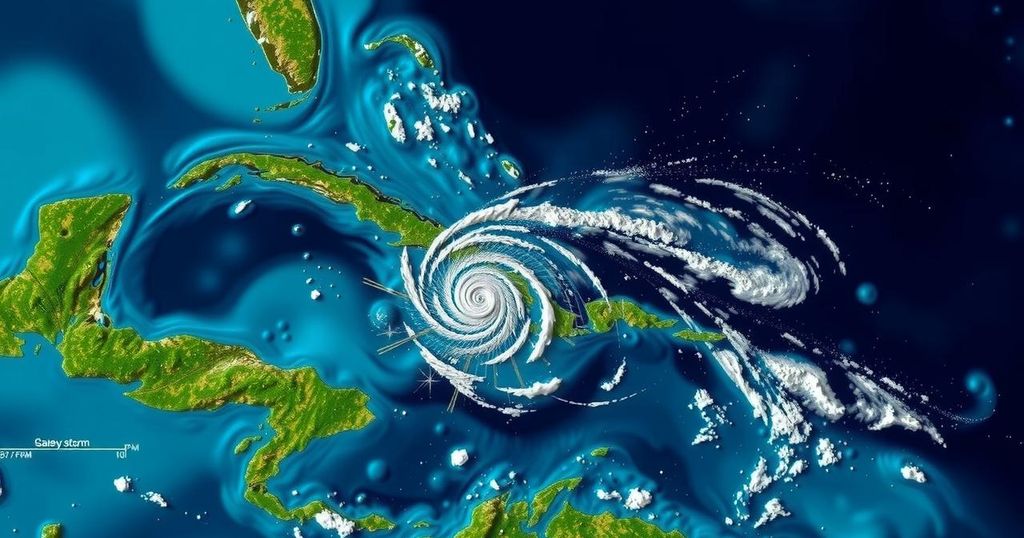Tropical Storm Oscar has evolved into a significant storm after making landfall in Cuba as a Category 1 hurricane, resulting in at least six deaths and heavy rains, and is now moving toward the Bahamas. The storm’s unexpected intensity has raised concerns within the meteorological community about hurricane forecasting accuracy. Meanwhile, the Atlantic hurricane season is expected to be above average this year.
Tropical Storm Oscar is actively moving toward the Bahamas following its landfall in Cuba as a Category 1 hurricane. The storm has resulted in at least six fatalities as it brought significant rainfall to an island already affected by an extensive power outage. As of Tuesday morning, Oscar was approximately 45 miles (75 kilometers) south-southeast of Long Island, Bahamas, with sustained winds recorded at 40 mph (65 kph) and a trajectory moving north-northeast at 12 mph (19 kph) as reported by the National Hurricane Center in Miami. However, the center noted that “Oscar is at best barely a tropical storm at this time.” Forecasts predict that the storm may deliver rainfall amounts reaching up to 5 inches (13 centimeters) across the southeastern Bahamas, with isolated areas potentially experiencing up to 8 inches (20 centimeters). Consequently, a tropical storm warning has been issued for the central and southeastern Bahamas. Oscar has made history by being recorded as the smallest hurricane ever, with a wind field spanning merely 6 miles (10 kilometers), which took many meteorologists by surprise as it made landfall on Grand Inagua Island in the Bahamas and again in eastern Cuba shortly thereafter. Michael Lowry, a hurricane specialist and expert in storm surge dynamics, expressed notable concern, stating, “It’s not often we see a colossal failure in hurricane forecasting,” as no predictive models suggested that Oscar would upgrade to hurricane status. In eastern Cuba, Oscar unleashed substantial rainfall, with accumulations exceeding 15 inches (38 centimeters) on Monday, raising the threat of heavy flooding and possible landslides. The six reported fatalities occurred in Guantánamo province, where the storm struck amid Cuba’s ongoing struggle with recovery from a recent major blackout that ignited minor protests and warnings from the governmental authorities about potential punitive responses to unrest. As the 15th storm and the 10th hurricane of the Atlantic hurricane season, which spans from June 1 to November 30, Oscar’s emergence was noted by the National Oceanic and Atmospheric Administration (NOAA), which predicts an above-average hurricane season this year, attributing this forecast to exceptional ocean temperatures. The agency anticipates the occurrence of 17 to 25 named storms over this season, with projections of four to seven of these reaching major hurricane status (Category 3 or higher). Additionally, Tropical Storm Kristy is currently located over open waters in the Pacific Ocean, approximately 375 miles (605 kilometers) west-southwest of Acapulco, Mexico, moving west-northwest at 15 mph (24 kph) with maximum sustained winds of 50 mph (85 kph), and is expected to transform into a hurricane by Tuesday night.
Tropical Storm Oscar has garnered attention due to its unexpected strength as a hurricane, highlighting challenges in meteorological forecasting. The storm’s impact was particularly severe as it struck Cuba, compounding issues arising from previous power outages and social unrest in the region. The context of hurricane season and climatic influences due to abnormal ocean temperatures provides further relevance to Oscar’s developments. The phenomenon of rapidly intensifying tropical systems continues to be a focus of research as environmental conditions shift, prompting increased scrutiny of forecasting methodologies.
In summary, Tropical Storm Oscar has developed into a significant weather event impacting Cuba and the Bahamas, leading to fatalities, extensive rainfall, and continued challenges for the affected regions. The unexpected transformation of the storm into a hurricane underscores the need for improved forecasting techniques in an era of changing climatic patterns. The ongoing Atlantic hurricane season is anticipated to present further challenges, as authorities prepare for additional storms, including Tropical Storm Kristy in the Pacific.
Original Source: www.seattletimes.com






